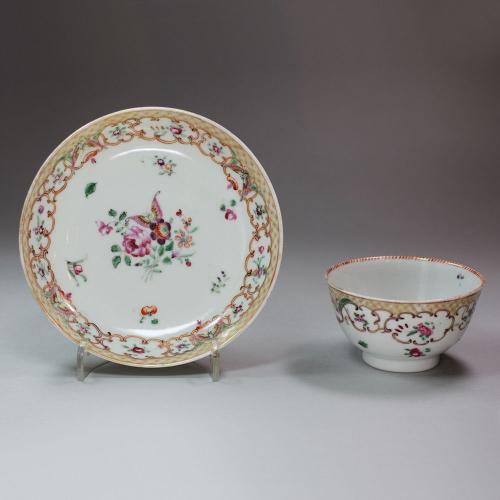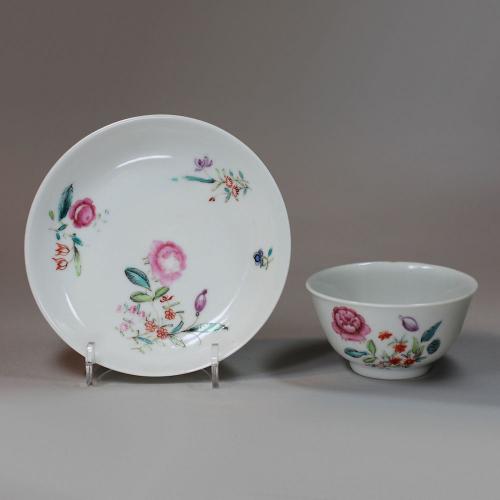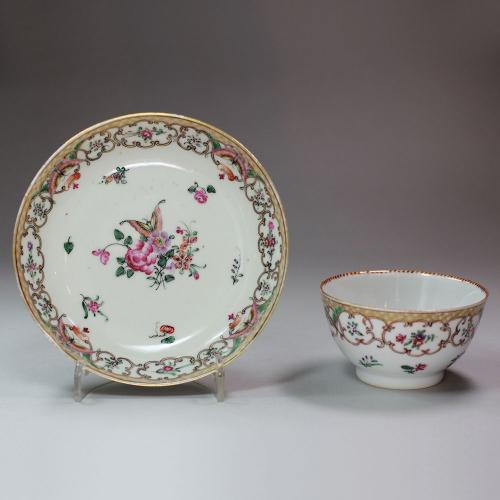
This object is eligible for a Certificate of BADA Provenance
The BADA Standard
- Since 1918, BADA has been the leading association for the antiques and fine art trade
- Members are elected for their knowledge, integrity and quality of stock
- Our clients are protected by BADA’s code of conduct
- Our dealers’ membership is reviewed and renewed annually
- Bada.org is a non-profit site: clients deal directly with members and they pay no hidden fees
Pair of Chinese blue and white phoenix-head ewers and covers, Kangxi (1662-1722), of octagonal ogee-shaped section with ribbed necks, flaring rims and ornate phoenix-form spouts; the bulbous bodies divided into four panels containing the flowers of the four seasons: lotus, chrysanthemum, peony and prunus, issuing from rockwork with flying insects above, between bands of lotus petals to the feet and ogee-shaped bands of scrolling lotus to the shoulders, the waisted necks divided into two sections; the lower with four panels of blooming peony and the upper with birds and insects in flight amongst floral sprays, the flaring bulb-form rims with further floral panels and surmounted by moulded peony-shaped lids, the gently curving spouts with foliate sprays and scrolling leaves, terminating in large phoenix-head openings.
Condition: Both covers with loss to one tab, and both existing tabs restored. One cover with star crack to interior and finial possibly off. Ewers with restored breaks to spouts. One with restoration to edge
Notes:
A similar pair of phoenix-head ewers but in famille verte from the Salting Bequest can be found in the collection of the V&A (C.1135&A-1910), and a similar pair is also illustrated in Jorg, Christiaan J.A. (2011) Famille Verte: Chinese Porcelains in Green Enamels, Groninger Museum, p.41, plate 30.
The earliest known Chinese phoenix-head ewers are from the Tang period in either sancai glazed stoneware (see an example in the collection of the Metropolitan Museum of Art 1975.1.1648) or white stoneware (Tokyo National Museum TG645), and in most cases seem to have been produced specifically for burial as part of funeral rites. It is believed that these early examples were based on metal ewers from Sasanian Persia (224–651 C.E.), and are testament to both the expansive trade network of the time and the exotic tastes of wealthy Chinese elites. Though originally it was the teardrop-shaped rim of the vessel which formed the phoenix-head element, over time the style developed so that the phoenix-head spout also included a long neck and was separated from the main body. The phoenix, or fenghuang, holds particular significance within Chinese mythology and was believed to be sacred king of all birds and a symbol of good fortune, fertility and longevity. Often depicted with the head of a pheasant, a long neck and the tail of a peacock, it is particularly fitting that in this instance, on vessels whose form for Kangxi consumers would have referenced the wares of a much older time, it is a pair of phoenix depicted rather than a single bird. In ancient China, the fenghuang had consisted of two separate entities to represent yin and yang; the male bird (鳳, feng) and female (凰 huang), but during the Ming the two gradually merged to become the symbol of female royalty, while the dragon was associated with the Emperor. The motif of the flowers of the four seasons, comprising chrysanthemum (autumn), prunus (winter), peony (spring) and lotus/iris (summer), is also an ancient one which was transmitted via trade across Asia and thus features in the art of many cultures to represent the passing of time.
Condition report
Both covers with loss to one tab, and both existing tabs restored. One cover with star crack to interior and finial possibly off. Ewers with restored breaks to spouts. One with restoration to edgeStock number
W750The BADA Standard
- Since 1918, BADA has been the leading association for the antiques and fine art trade
- Members are elected for their knowledge, integrity and quality of stock
- Our clients are protected by BADA’s code of conduct
- Our dealers’ membership is reviewed and renewed annually
- Bada.org is a non-profit site: clients deal directly with members and they pay no hidden fees




